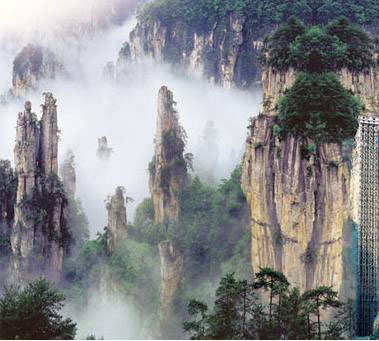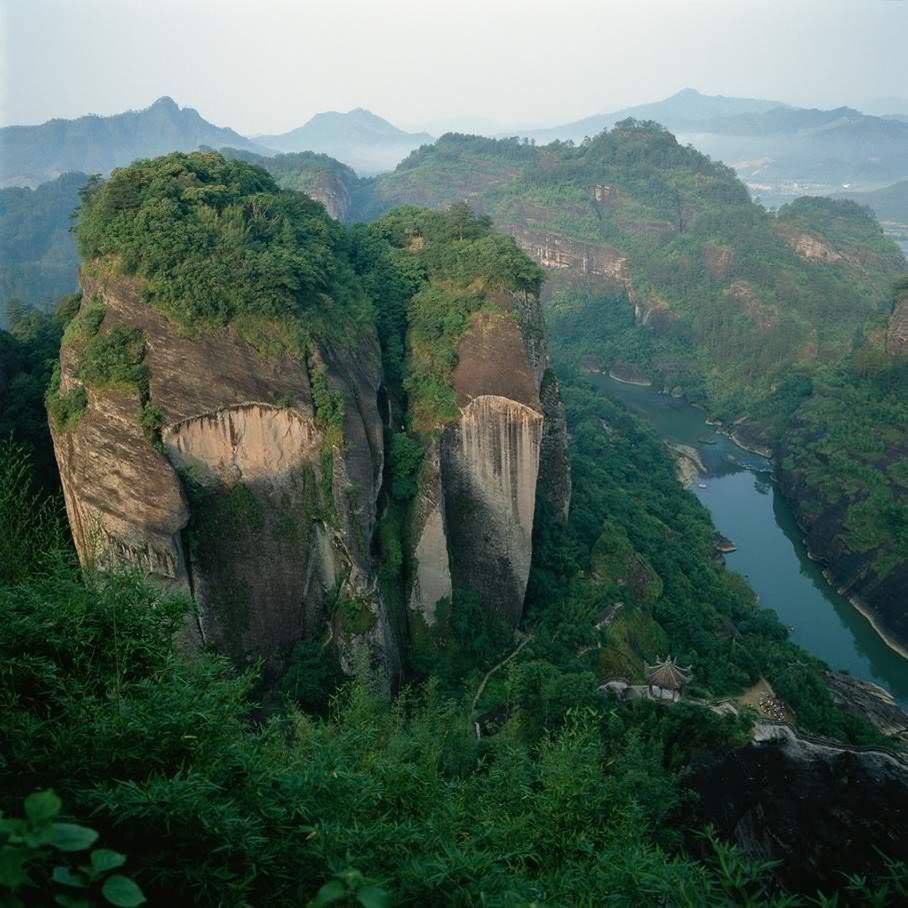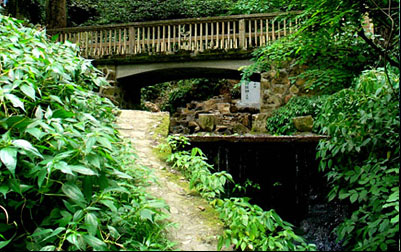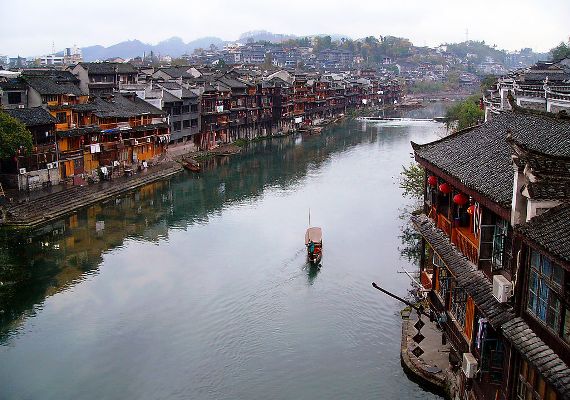Zhangjiajie Tourism

Zhangjiajie is located in northwestern Hunan Province. To get there, you might take train or bus for 5 hours ride from Changsha, the capital of this province.
Local scenic hotspots include the Zhangjiaie National Forest Park, the Tianzi Mountain and Badagong Mountain nature reserves and the Maoyan River. Its unique sandstone landscapes and its primeval forests make the Zhangjiajie National Forest Park a number one choice for visitors to the area. I was delighted at the opportunity to see and report on this scenic haven.
Primeval Natural Landscapes
At just 32 kilometers outside the city proper, Zhangjiajie National Forest Park is regarded as the city's back garden. After a 20-minute drive, we arrived at the park. Having just left the noisy city behind, I felt we had entered another universe. It was a journalist named Yang Fei, who traveled the area 25 years ago, that first revealed its beauty to the public in 300 breathtaking photographs.
These shots also caught the attention of China's State Council, which in 1982 made the Zhangjiajie National Forest Park the first of its kind in the country. People come from all over the world to marvel at its dramatic rock formations, rivers, valleys, and primeval forest.
This vast park covers a total of 4,810 hectares. There are six scenic areas: Jinbian (Golden Whip) Brook, Pipa (a plucked string instrument) Brook, Huangshizhai (Yellow Lion) Mesa, Yaozizhai (Sparrow Hawk Mesa) Village, Shadao (Sand Sword) Gully and Yuanjiajie mesa.
The panoramic view from Yaozizhai, at the mountain summit overlooking the mountainside, stole my breath. With an average annual temperature of 12.8 degrees Celsius and a forestation rate of 98 percent, Zhangjiajie air is so pure that you won't want to leave. There are 517 different species of plant and trees, including 7 rare species under Category I national protection. Home to 41 species of bird and 28 species of animal, Zhangjiajie Natural Forest Park enjoys a reputation as the country's natural zoo.
Zhangjiajie's landscape is the result of 380 million years of nature's machinations. Three hundred and eight million years ago, the area was under the sea, where halobios fossils formed layers of soil and rocks. Earth movements elevated the seabed above the water's surface, and submerged other tracts of land. This cycle continued until, at the last Yanshan Mountain deformation, the area rose up from the sea, rock layers splitting, and crevasses expanding, to become today's Zhangjiajie, whose ruggedness is also the result of water, wind and rain erosion.
Zhangjiajie is best known for its towering peaks, cloaked in cloud and mist, and covered in different shades of green. Thick shrubs cover the cliff surface, and pines flourish on the mountaintops. Various shapes can be discerned in its peaks -- of animals, swords and humans. An aerial view of the peaks presents an even more impressive view -- a veritable forest of corals in a blue fathomless sea.
In the late 1970s renowned artist Wu Guanzhong came to Zhangjiajie. He was greatly touched and inspired by the purity of its natural beauty, and subsequently produced his masterpiece, Zhangjiajie . He also wrote an article entitled, "An Unknown Nurtured in the Recess of the Boudoir," in which he eulogized Zhangjiajie as a scenic gem tucked away in the depth of the mountains. Today Zhangjiajie is a popular tourist destination, and Wu Guanzhong's painting is on exhibit at a French museum.
Of Zhangjiajie's magnificent mountains, Tianmen might be the most characteristic. A few kilometers south of the city stands a solitary cliff-faced mountain, within which is a huge opening, known as the Celestial Gate -- the name of the mountain. In 1999 various international stunt pilots flew their planes through this opening.
It is said that Zhangjiajie has 3,000 peaks and 800 bodies of waters, including springs, streams, lakes, waterfalls and pools. They never dry up even in drought years, and remain clear even after a heavy rain. Along the Jinbian and Liansuo streams are a series of picturesque spots. The Yuanyang Waterfalls cascade from a height of 100 meters, their thunder echoing through the mountains. Baofeng Lake is a crystal-clear alpine lake cupped in green mountains.
Brand-new Traveling Experience
Twenty years ago, stout, waterproof boots were a must for a visit to the Zhangjiajie National Forest Park, due to its muddy mountain paths. These days, trainers are fine for a visit to the Zhangjiajie National Forest Parkas the paths have been paved. But new developments have not come at a cost to nature. The park management pride themselves on their principle of protection first, development second. A whole host of new conveniences and facilities, including hotels, post offices, department stores, hospitals, banks and schools have been built either inside or around the park, bringing both tourists and local residents the services they need. In protecting the forest, the park management has built seven forest fire prevention areas and a 52-kilometer-long fire prevention belt, in addition to the Huangshizhai Protective Watchtower. The park has not seen a single outbreak of fire, plant disease or pests for the past 40 years, and as a result, it has been awarded the title of AAAA National Resort. When I learned all this, I had the utmost respect for the park management and their hard work in protecting this natural labyrinth of trees.
Initiated in 1991, the Zhangjiajie International Forest Protection Festival brings the park to the world. Visitors are treated to special forest tours, geological tours and there are international rock and mountain climbing contests. Other entertainment includes Tujia ethnic singing and dance and spectacular qigong performances. The Tujia wedding customs that I witnessed were particularly interesting. The bride-to-be, her brothers and sisters cry for an entire fortnight before the wedding day. The more tears they shed, the more money they will get from the parents! Some ten million visitors from the Chinese mainland and overseas have walked through this park in the past decade, yet its natural beauty remains unspoiled. On July 19th, 2004, the Zhangjiajie National Forest Park cemented its international status when it was twinned with Austria's Ho-he Tanerh National Forest Park
In November 1935, during the epic Long March, the Red Army passed through the Jinbian Brook. To commemorate the historical event, Zhangjiajie National Forest Park opened the Red Army Route. During my tour of Zhangjiajie, I was honored to have the opportunity to sit and talk with some Red Army veterans, and hear their stories amid the babbling brooks of this lush green forest.
Six Scenic Areas:
Jinbian Brook Located at the eastern part of the park, the Jinbian Brook's marvelous canyon is one of the world's most beautiful, and is a must-see for any visitor to Zhangjiajie. The brook is flanked by beautiful flowers and grasses and strolling along the brook, as birds chirp and the cicadas sing is a truly uplifting experience. Recommended spots here include: Sun Gate Reflection, Golden Whip Rock, Violet Grass Pool, and the Pool of Leaping Fishes.
Huangshizhai Located in the west of the park, at 1,200 meters above sea level, is the park's largest viewing terrace. There is a saying: Without climbing to Huangshizhai, your trip to Zhangjiajie is not complete. It has 20 scenic spots, including the South Heavenly Gate and the Star-gazing Platform.
Pipa Brook Located at the western part of the forest park, this narrow valley forms the central line of the scenic area, and its unique scenic spots are mainly dotted around the north side of the brook. Starting from Pipajie and climbing the mountain ridge to Chaotian Temple site, along the route you can enjoy sights like the Husband and Wife Rock, and the Dragon and Phoenix Rock.
Yaozizhai This is a mesa with three 300-m-deep cliff sides at 1,050 meters above sea level in the southeast of the forest park. Its 1,400-m-long and 100-m-wide tabletop is an adventurer's dream destination.
Shadao Gully This V-shaped gully lies in the northeast of the forest park. The 20-30 meter wide gully is well known for its primitive scenery. Its main scenic spots include Qingxin (Tranquil) Pool, the Peacock's Spreading Tail, and Moon Rainbow.
Yuanjiajie Located at the north of the park, Yuanjiajie is a mesa that overlooks a deep valley and a chain of mountain peaks. Its main scenic spots include: The World's First Bridge, the Back Garden, and the Stage for Departed Souls.






